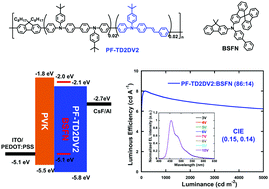Achieving highly efficient blue light-emitting polymers by incorporating a styrylarylene amine unit†
Abstract
A series of novel blue light-emitting polymers were designed and synthesized by incorporating a blue styrylarylene amine (DV) chromophore into the backbone of poly(9,9-dioctylfluorene). All the resultant polymers exhibit blue emission peaking at around 465 nm. The fabricated single layer polymer light-emitting devices based on PF-TD2DV2 consisting of 2 mol% of the DV moiety present an impressively high luminous efficiency of 5.47 cd A−1 with Commission International de L’Eclairage (CIE) coordinates of (0.15, 0.14). The luminous efficiency can be further improved to over 8 cd A−1 upon the incorporation of a hole transport layer of polyvinylcarbazole and the blending of a hole transport material N-([1,1′-biphenyl]-4-yl)-N-(9,9-dimethyl-9H-fluoren-2-yl)-9,9′-spirobifluoren-2-amine (BSFN) into the emissive layer. Of particular importance is that the luminous efficiency remains 7.40 cd A−1 at a brightness of 1000 cd m−2, and the devices exhibit excellent stability of electroluminescence with the variation of driving voltage from 3 to 10 V. These results demonstrate the great potential of this class of polymers for application in solution processed blue light-emitting diodes.



 Please wait while we load your content...
Please wait while we load your content...